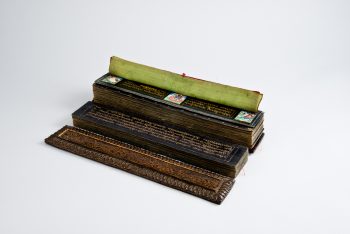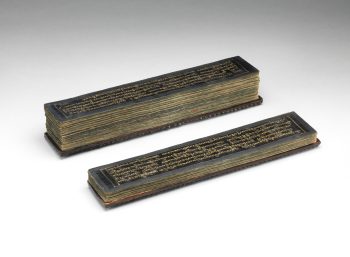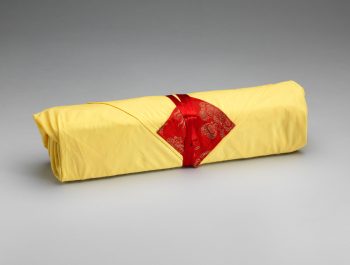Tibet
dated no later than 1635




Tibet
dated no later than 1635




This illuminated manuscript contains the writings and oral instructions of Lochen Gyurme Dechen (1540–1615), a Buddhist master of the Shangpa Kagyu tradition. Complete with carved and decorated wood covers, gold calligraphy, and numerous illuminations, it represents an exceptional, tangible way of honoring and preserving the words of a master. The volume consists of several texts and includes twelve miniature paintings dispersed throughout. Four illuminations include images of the author and another depicts the great adept and Tibetan cultural hero Tangtong Gyalpo (1361-1485), whose biography Gyurme Dechen is best remembered for. Also shown are Rigden Namgyal Drakpa Zangpo and Niguma, and Indian female adept.
Teachings and precepts that offer practical and experiential guidance. In Buddhism instruction is primarily an oral tradition and is often targeted to the specific needs or disposition of a student or disciple.
The antidote to ignorance, with the highest form of wisdom being an understanding of the true nature of reality and all phenomena. In Buddhism studying the nature of interdependence and emptiness is considered an important step for attaining wisdom.
Himalayan art includes portraits of legendary and historical humans, including accomplished religious teachers (lamas), the Buddha’s original disciples (arhats), and spiritually accomplished tantric masters (mahasiddhas).
Today, Tibetans primarily inhabit the Tibetan Plateau, situated between the Himalayan mountain range and the Indian subcontinent to the west, Chinese cultural regions to the east, and Mongolian cultural regions to the northeast. During the 7th to 9th century, Tibetan rulers expanded their empire across Central Asia, and established Buddhism as the state religion.
Get the latest news and stories from the Rubin, plus occasional information on how to support our work.